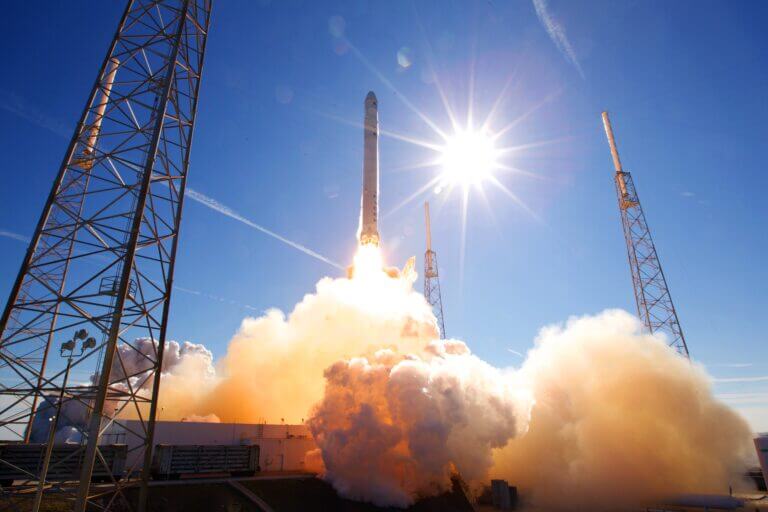Testing the acoustic environment assists in verifying the structural integrity of aircraft, launch vehicles, and satellites. Test performance validates the environments that are used in the design and analysis process and can confirm that a structure will survive through acoustic qualification testing. ATA has hardware and software that allows the measurement of acoustic environments for a wide variety of testing conditions.
Additionally, ATA has worked to develop specialized techniques to measure the highly detailed acoustic fields produced by aircraft engines. This technique, scanning acoustic holography, utilizes fixed and moving array microphones to provide essentially infinite spatial resolution of the acoustic environment around a noise source.
Rocket engines for launch vehicles produce extremely high dynamic fluctuating pressure, which creates a challenging environment for launch vehicle and satellite components exposed to these acoustic loads. Test measurements of the actual acoustic environment are important for achieving proper analysis of a structure’s ability to survive such extreme load cases. To measure jet plume fluctuating pressures, ATA is able to deploy unique solutions of instrumentation and data collection equipment that can withstand the challenging temperature, vibration, and sometimes abrasive environment. Definition of the actual acoustic environments also provides the information to be used in qualification testing.

Measurement of structural responses to the acoustic environment that will be applied to a system is important in verifying that the system will survive the sometimes severe conditions. Acoustic qualification testing is performed in the aerospace industry to confirm that the system will survive harsh conditions. ATA has experience in providing the engineering personnel and equipment needed to support acoustic qualification test programs. In addition to collecting test data during acoustic tests in reverberation chambers, ATA has assisted in the performance of acoustic tests using direct field acoustic testing (DFAT). ATA has substantial data collection resources and instrumentation for making all of the measurements required for this type of testing.
The following are typical DFAT and reverberation chamber measurements:
- Microphone/pressure
- Acceleration
- Strain

Interior noise for vehicles is important to occupants, whether ground or air vehicles are involved. Measuring the acoustic environment in the interior of a vehicle requires specialized expertise and hardware to make appropriate measurements at appropriate locations. ATA performs aircraft in-flight acoustic testing to help assess the passenger environment and to determine whether any mitigation techniques can be implemented. Our experience includes recording microphone and acceleration measurements during flight to quantify noise paths and sources in an aircraft cabin, engine compartment, and other cavities. These measurements are key inputs for statistical energy analysis (SEA) models that are used to rank noise paths and sources. The models are then used to evaluate noise reduction and interior design modifications to optimize the cabin noise reductions. Overall weights and noise levels are reduced as a result, saving money and increasing quality and passenger comfort.

Environmental noise can be quantified in terms of acoustic levels and frequency content. Measurement of environmental noise is particularly important in work environments and in urban locations. In evaluating environmental noise, it is important to not only quantify the acoustic environment but also assess the noise sources causing the noise. ATA assesses the source of acoustic emissions so that possible mitigation techniques can be deployed to decrease the environmental noise.

Acoustic source localization is effective at troubleshooting noise issues, enabling the development of more-effective noise mitigation strategies by providing a visualization of the strength and spatial extent of noise sources. Through a number of projects funded by the Air Force, Navy, and NASA, ATA has developed a unique source localization technique based on high-spatial-resolution continuous-scan acoustic measurements. One of the main advantages of ATA’s continuous-scan-based beamforming and acoustical holography is that array performance can be improved without increasing sensor counts. In particular, continuous-scan beamforming is capable of discerning secondary sources that cannot be identified by conventional methods employing stationary arrays. ATA can provide the engineering personnel and equipment needed to support acoustic phased-array testing.

Connect with us to discuss how our advanced multi-disciplinary team can help you achieve your engineering goals.



